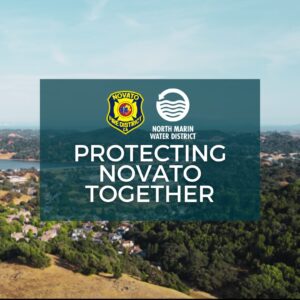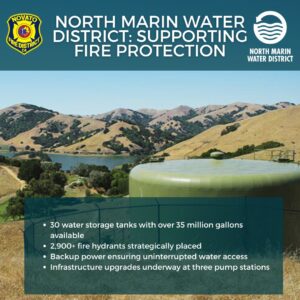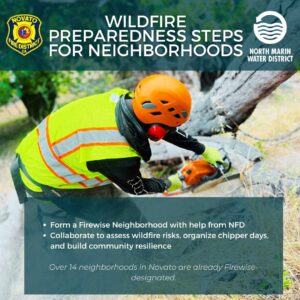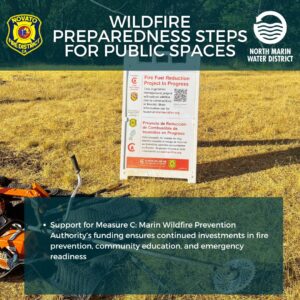(Posted July 15, 2025) The North Marin Water District will be initiating the San Mateo Tank Transmission Project starting in August 2025 with an expected completion sometime in October 2025. This project involves installation of a new, large-diameter transmission main that will extend from the San Mateo Tank and connect to the existing distribution system along San Mateo Way. Project benefits include increased fire flows for the San Marin area and decreased pumping costs.
Find out more by emailing SMTTransmissionmain@NMWD.com or visiting https://nmwd.com/business/current-projects/
(Posted June 25. 2025) The District would like to invite you to visit our brand new low water use Demonstration Garden located at our remodeled administration building at 999 Rush Creek Place in Novato, recently re-opened. Created to provide examples of beautiful low water use plants that thrive in our Novato climate, we hope it inspires you to choose plants for your own landscape that flourish with less water. The Demonstration Garden is drip irrigated using recycled water and rainwater, and a weather-based controller automatically adjusts the irrigation schedule based on the current conditions. Having a garden that is water-smart and beautiful is easy and the plants found in the garden are only a small sample of the possibilities for your water-wise garden. Bear with us as the plants are still a bit young, but you are welcome to come by and visit the front portion anytime.
Find the perfect plants for your garden and more information about the plants in this Demonstration Garden, including a self-guided garden map with a detailed plant list here.
(Posted June 11, 2025) North Marin Water District recently increased the incentive for replacing regularly maintained, irrigated lawns with District-approved low water use plantings on drip irrigation. The incentive is now $1.50 per square foot of lawn area if you replace it with qualified low water use planting (up to $1,500 per single-family dwelling) and an additional per square foot rebate if the project meets the additional Marin County Stormwater Pollution Prevention Program’s criteria for delayed stormwater runoff.
Pre-qualification virtual inspection and re-landscaping plan approval are required for participation. To learn more about the program and the qualifications for the different rebate levels and to see if your project qualifies, click here or call 415-761-8944.
(Posted April 24, 2025) Join us for the Eco-Friendly Garden Tour! We’re excited to announce that the Eco-Friendly Garden Tour is back for its 15th year. Whether you’re a seasoned gardener or simply someone who enjoys the beauty of nature, this tour will open your eyes to the endless possibilities of sustainable gardening practices. Many of the gardens on the tour will have educational tables, plant/seed giveaways, demonstrations and more! Along with gardens in both counties, we have two awesome gardens to visit in Novato! We can’t wait to see the incredible native gardens in our community and celebrate the beauty of eco-friendly landscaping together.
Why Attend?
- 🌿 Learn new eco-friendly gardening practices.
- 🌻 Get inspired by local, sustainable garden designs.
- 🌍 Meet other inspired gardeners.
- 🌼 Support local non-profits.
Event Details
Date: Saturday, May 10th
Time: 10 am – 4 pm
Location: Sonoma and Marin County
Cost: FREE! Registration Required.
RSVP: savingwaterpartnership.org/eco-friendly-garden-tour/
(Updated April 24, 2025) The North Marin Water District has approved a rate study for the West Marin Service Area. The District Board of Directors initiated the rate study due to known near and long-term critical capital improvement projects combined with increasing impacts of inflation, electricity costs and other costs that affect supplies, operations and construction. The rate study considered all of these impacts to appropriately plan for a long-term rate structure with a goal of establishing a secure, multi-year financial plan that supports operating costs and capital spending necessary to provide water services that are reliable, high-quality, environmentally responsible and reasonably priced. The rate study was approved by the Board at the April 15, 2025 Board meeting. For more information on the West Marin Rate Study, rate development process and final rate study document click here: www.nmwd.com/wmrates2025
In an effort to inform and educate the West Marin Service Area customers on the Rate Study, we have put together a series of presentations and a public hearing. Please consider attending one of the events below to learn more about the rate process.
- March 18, 2025 (4pm) – Board Meeting (Initial Rate Study Presentation)
- April 15, 2025 (4pm) – Board Meeting (Final Rate Study Presentation)
- May 6, 2025 (4pm) – Board Meeting (Capital Improvement Project Presentation)
- June 17, 2025 (4pm) – Public Hearing to enact new water rates
*Meeting Location: 999 Rush Creek Place, Novato, CA 94945
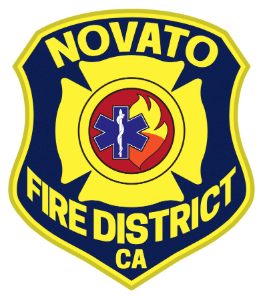
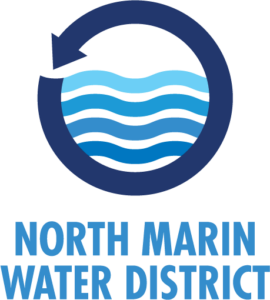
(Updated February 20, 2025) A Joint Message from Novato Fire District Fire Chief, Bill Tyler and North Marin Water District General Manager, Tony Williams
(This joint message was presented to the Novato City Council on January 28, 2025. To view that presentation click HERE.)
We are currently witnessing urban conflagrations in Southern California that have been described as unfightable fires. Novato Fire answered the call and deployed personnel and equipment, including a water tender, down to SoCal to help. Human-caused fires, under red flag conditions, rapidly expanding due to extremely high winds, low humidities, and dry receptive vegetation sending brands and embers showering into neighborhoods, on homes and businesses. These homes ignite by embers landing in vegetation immediately adjacent to the structure bringing direct flame contact, or embers penetrating features of combustible construction, entering homes through vulnerable porous vents, gathering in combustible eaves, openings in roof coverings, sparking debris in gutters, starting on combustible decks and patio furniture—and so on. There are many, many vulnerabilities in our current built environment. Once homes begin to ignite under these conditions there is a domino effect of home-to-home ignitions. The radiant heat flux of a structure fully engulfed in flames threatens other homes that are in close proximity, casting even more ember showers being lifted into convective smoke columns and landing long distances away, starting new fires. Can the same thing happen here in Novato? Yes, unfortunately, it can
What are we as a community to do? There are several important steps that each and every one of us can take to protect our properties and become more resilient home by home, neighborhood by neighborhood, and in public and private open space areas. For homeowners, start where you stand. First and foremost sign up for a FREE in-person home evaluation from one of our NFPD wildfire mitigation specialists. Once the in-person assessment is completed, you will be given a written prescription or road map on things you can immediately do and provide you with access to local matching grants for thousands of dollars to incentivize you to modify your existing fire-prone landscapes and replace existing combustible construction with ignition resistant construction features. Insurance companies are now recognizing new and existing homes that are being built or remodeled to an IBHS “Wildfire Prepared Home” and “Wildfire Prepared Home Plus” standards. Achieving these designations makes it very likely that one will receive insurance coverage from existing admitted insurers. Some insurance companies may even provide discounted rates on existing or new policies. We can also come together as a neighborhood and form a group and apply to become a National Fire Protection Association, designated Firewise Neighborhood. NFPD staff will come to your neighborhood and help you get started. We will help you do an informed neighborhood wildfire assessment. We will help you come up with a plan to address common areas of concern. Get you signed up for chipper days where you can organize to help your neighbors prepare their own homes which will in turn make the neighborhood more resilient to wildfire. This coming together and becoming Firewise has already occurred in over 14 Novato neighborhoods already, please join them. Also important to know, many vegetation reduction projects have been completed or are in progress in private and public open space areas or have been completed in and around Novato. We are in phase one of implementing the Greater Novato Shaded Fuel Break (GNSFB) This is an area around the entire district from 100ft to 300ft where dead and downed trees have been removed, existing trees limbed up, invasive plants removed, French broom pulled and seasonal grasses cut. We will also be doing additional burn piles of cleared vegetation and look to plan and execute prescribed burns in the future. Dozens of miles of evacuation clearing have been accomplished making routes out of impacted areas more protected if you are in your vehicle on your way out. Lastly, the public support for the Marin Wildfire Prevention Authority and its funding mechanism, Measure C, needs to be supported and renewed when the time comes. We are 5 years into a 10-year commitment on behalf of the public which provides $20 million dollars a year to all Marin communities to focus on improving evacuation notification and warning systems, fire prevention education, mitigation grant funding reinvested back into the community, substantial vegetation fuel reduction projects, home and business evaluations, and more. Many times as firefighters we are told, “Thank You” for what we do, but I want to say Thank you! We love what we do, and we know you will be there to support us when we need you. We need everyone to take action now and, in the future, in conjunction with our North Marin Water District partners supplying water to fight these “unfightable fires.”
Novato Fire Safety and Water
Given the horrific conditions in Southern California we wanted to remind our customers what role North Marin Water District (District) plays in fire planning, suppression, prevention, and safety. Each day, the District ensures that 25 million gallons of water or more is stored in thirty different water storage tanks located throughout the distribution system, ranging in capacity from 5,000 gallons to 5 million gallons. With careful planning, the stored volume could be increased to over 35 million gallons. These storage tanks are connected to the District’s water distribution system which also includes over 2,900 fire hydrants strategically spaced throughout the community, mostly near homes, schools, and commercial development. The District installs additional fire hydrants, in coordination with the Novato Fire Protection District (Novato Fire), whenever new water pipelines are installed or replaced; and replaces hydrants if damaged (usually by a vehicle). The Fire District handles blue marker street identification, hydrant clearance, and painting the hydrants to protect them from the elements and to extend their life. The District relies on the hydrants for routine testing/flushing of pipelines as well as for temporary connections for special needs, and obviously the Fire District relies on the hydrants for fighting fires and protecting the community.
In order to fill the 30 water storage tanks, the District relies on 25 pump stations. The pump stations pump the water uphill to the tanks which are situated at higher elevations, taking advantage of gravity to provide pressure to the distribution system from the full tanks. In coordination with Novato Fire, the District has established specific storage and flow rates in the distribution system for firefighting purposes which dictates the design and operation of the storage tanks and pump stations. The pump stations require electricity for two main functions: communications for control, and power to run the pumps. Backup power is provided to all communication systems via batteries and the pumps are capable of running off auxiliary power, usually in the form of a portable generator. The District owns nine large portable generators and 10 smaller portable generators for this purpose. In addition, the District has a strategic deployment plan developed from our experience with prior PG&E Power Safety Shutoffs but it also provides flexibility to modify for other events. The District also has a stationary large battery storage capability at one of the largest pump stations and a stationary generator at the Stafford Treatment Plant.
The District has an extensive distribution system to ensure we always have available water for human consumption and firefighting purposes. In an effort to continually improve and update this system, the District is currently embarking on three projects that will help make our distribution system more effective and robust for reliability and fire protection in the coming years. These projects include the Lynwood Pump Station Upgrade Project, the Crest Pump Station Project, and the San Mateo Tank 24-inch transmission water main project.
Learn More:
www.novatofire.org
www.firesafemarin.org
www.marinwildfire.org
Wildfire Prepared Home, a Program of IBHS – Resources
www.nmwd.com
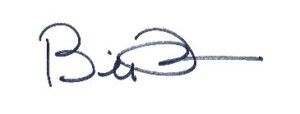

Bill Tyler Tony Williams, P.E.
Fire Chief General Manager
Novato Fire District North Marin Water District
